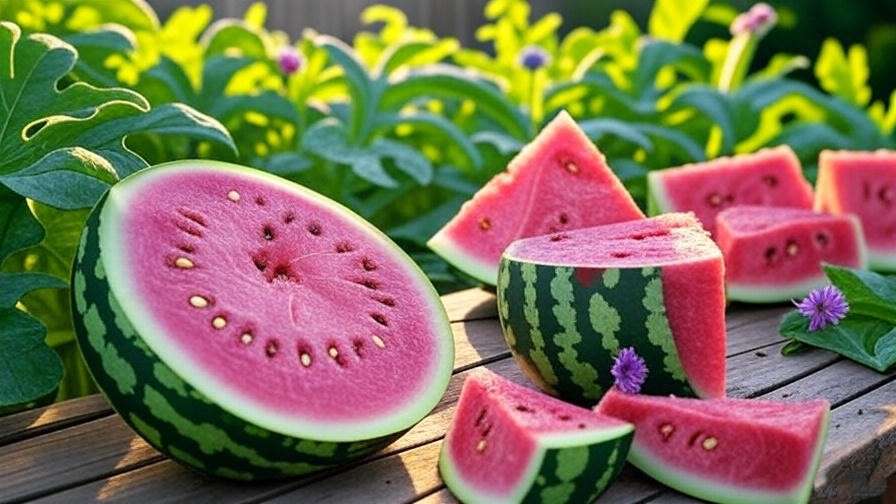Picture this: slicing open a watermelon to reveal a stunning purple flesh that turns heads and sparks conversations at your next summer gathering. Purple watermelon seeds are the key to unlocking this vibrant, exotic addition to your garden. As a horticulturist with over a decade of experience cultivating rare fruit varieties, I’ve seen the magic these seeds bring to both novice and seasoned gardeners. Yet, finding reliable information on sourcing, planting, and caring for purple watermelon seeds can be a challenge. This comprehensive guide addresses that gap, offering expert-backed steps to grow these unique fruits successfully. From selecting authentic seeds to harvesting juicy, colorful watermelons, here’s everything you need to cultivate a standout crop.
What Are Purple Watermelon Seeds?
The Origins of Purple Watermelons
Purple watermelons, though less common than their red-fleshed cousins, have a fascinating history rooted in selective breeding and heirloom cultivation. Originating from regions like Southeast Asia and parts of Africa, these varieties were developed for their unique pigmentation, often linked to higher antioxidant levels. Some purple watermelons, like the ‘Moon and Stars’ cultivar, trace back to heirloom strains, while others are modern hybrids bred for vibrant color and flavor. Their rarity makes them a prized choice for gardeners aiming to diversify their plots and impress with visually striking produce.
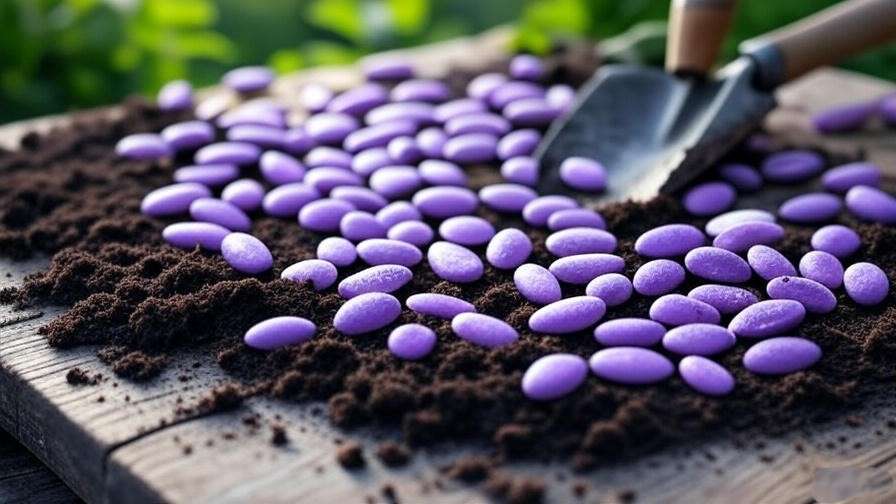
Characteristics of Purple Watermelon Seeds
Purple watermelon seeds differ slightly from traditional ones in appearance and behavior. Typically dark brown or black with subtle striping, they produce fruits with flesh ranging from deep violet to reddish-purple, often speckled with contrasting seeds. The fruits vary in size, from petite 5-pound melons to larger 20-pound giants, depending on the cultivar. Their flavor profile leans sweeter than standard watermelons, with a crisp, juicy texture that’s perfect for fresh eating or juicing. These seeds require similar germination conditions but demand extra care to thrive due to their specialized genetics.
Why Grow Purple Watermelons?
Growing purple watermelons offers more than just aesthetic appeal. Their rich anthocyanin content, responsible for the purple hue, may provide health benefits like anti-inflammatory properties. For gardeners, they’re a chance to stand out—whether at farmers’ markets or in community garden showcases. They also contribute to biodiversity, supporting sustainable gardening practices by preserving rare varieties. Whether you’re a hobbyist seeking a unique challenge or a commercial grower tapping into the exotic produce trend, purple watermelons deliver both beauty and value.
Sourcing High-Quality Purple Watermelon Seeds
Where to Find Authentic Seeds
Finding genuine purple watermelon seeds is the first step to a successful harvest. Reputable suppliers like Baker Creek Heirloom Seeds, Seed Savers Exchange, and Johnny’s Selected Seeds offer verified varieties such as ‘Blacktail Mountain’ or ‘Purple Sugar Baby.’ Online platforms like Etsy or Amazon may carry seeds, but beware of mislabeled or low-quality products. Local nurseries specializing in heirloom or organic seeds are also excellent sources. Always check customer reviews and seed certifications (e.g., non-GMO, organic) to ensure authenticity and viability.
Factors to Consider When Choosing Seeds
Not all seeds are created equal. When selecting purple watermelon seeds, prioritize:
- Viability: Choose seeds with a germination rate of 85% or higher, typically indicated on the packet.
- Climate Suitability: Opt for varieties suited to your USDA hardiness zone (most thrive in zones 4–9).
- Source Credibility: Select seeds from breeders known for exotic or heirloom varieties to avoid hybrids mislabeled as purple.
A quick tip: Contact suppliers directly to confirm seed provenance, especially for rare cultivars.
Expert Tip: Seed Storage Best Practices
To maintain seed viability, store purple watermelon seeds in a cool, dry place, ideally at 40°F (4°C) with low humidity. Use airtight containers or vacuum-sealed bags to prevent moisture damage. Label packets with the purchase date, as seeds remain viable for 4–5 years under optimal conditions. For long-term storage, consider a refrigerator (not freezer) to extend shelf life. Check seeds annually for mold or discoloration, discarding any that show signs of deterioration.
Planting Purple Watermelon Seeds: Step-by-Step Guide
Ideal Growing Conditions
Purple watermelons thrive in warm, sunny environments with specific soil and climate needs:
- Soil: Well-drained, loamy soil with a pH of 6.0–6.8.
- Sunlight: At least 6–8 hours of direct sun daily.
- Temperature: Soil temperatures above 70°F (21°C) for germination, with daytime air temperatures of 75–85°F (24–29°C).
Compared to traditional watermelons, purple varieties may need slightly richer soil to support their vibrant pigmentation. Test your soil with a kit and amend with compost or organic matter if needed.
| Factor | Purple Watermelon | Traditional Watermelon |
| Soil pH | 6.0–6.8 | 6.0–7.0 |
| Sunlight | 6–8 hours | 6–8 hours |
| Germination Temp | 70–85°F (21–29°C) | 70–90°F (21–32°C) |
| Days to Harvest | 80–100 days | 70–90 days |
When and How to Plant
Plant purple watermelon seeds in spring, after the last frost, when soil temperatures reach at least 70°F (21°C). For most USDA zones, this is late April to early June. Follow these steps:
- Prepare the Soil: Till to a depth of 12 inches, mixing in compost or aged manure.
- Sow Seeds: Plant seeds 1 inch deep, 2–3 seeds per hill, with hills spaced 4–6 feet apart.
- Water: Water thoroughly after planting, keeping soil consistently moist but not waterlogged.
- Mulch: Apply organic mulch (e.g., straw) to retain moisture and suppress weeds.

Germination Tips for Success
Boost germination with these expert techniques:
- Soak Seeds: Soak seeds in lukewarm water for 12–24 hours to soften the seed coat.
- Use Seedling Trays: Start seeds indoors 3–4 weeks before the last frost for a head start, then transplant.
- Maintain Warmth: Use a heat mat to keep soil at 75–80°F (24–27°C) during germination.
If germination fails, check for overly wet soil or temperatures below 65°F (18°C). Replant with fresh seeds if needed.
Caring for Purple Watermelon Plants
Watering and Fertilizing
Purple watermelons require consistent moisture, especially during fruit development. Water deeply once or twice weekly, providing 1–2 inches of water, adjusted for rainfall. Avoid overhead watering to prevent fungal issues. Fertilize with a balanced organic fertilizer (e.g., 10-10-10) at planting, then switch to a phosphorus-heavy blend (e.g., 5-10-10) when flowers appear to support fruit growth. Apply fertilizer every 2–3 weeks, following package instructions to avoid overfeeding.
Pest and Disease Management
Common pests include aphids, cucumber beetles, and spider mites, while diseases like powdery mildew and fusarium wilt can threaten crops. Use these eco-friendly controls:
- Pests: Introduce beneficial insects like ladybugs or use neem oil sprays.
- Diseases: Ensure good air circulation by spacing plants properly and apply organic fungicides like sulfur for mildew.
Regularly inspect plants and remove affected leaves promptly. Crop rotation every 3–4 years prevents soil-borne diseases.
Pruning and Training Vines
Pruning enhances fruit quality and manages vine sprawl. Remove secondary vines after the main vine sets 2–3 fruits to focus energy on fruit development. Train vines along a trellis or fence for space-saving, using soft ties to avoid stem damage. A simple A-frame trellis works well for supporting heavy fruits, especially in small gardens.
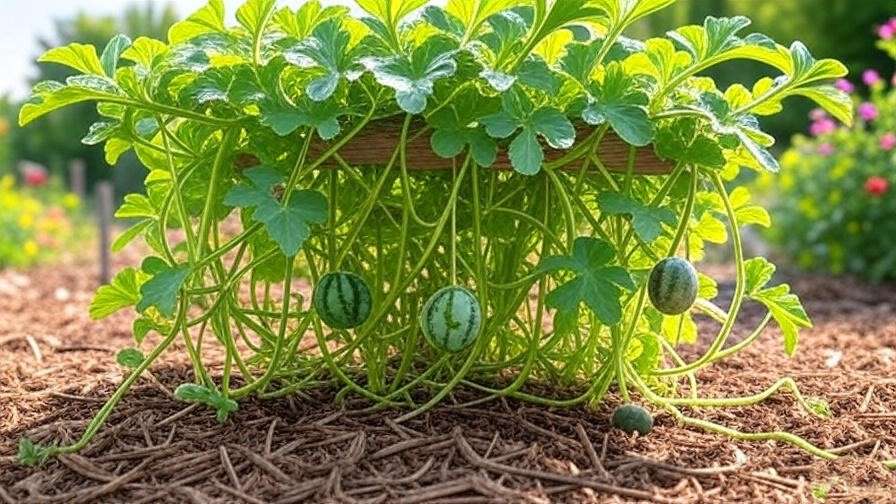
Harvesting and Enjoying Purple Watermelons
When to Harvest
Knowing when to harvest purple watermelons ensures peak flavor and texture. Most varieties mature in 80–100 days, depending on the cultivar and growing conditions. Look for these signs of ripeness:
- Rind Appearance: The rind turns dull, losing its glossy sheen.
- Underside Spot: The spot where the melon rests on the ground changes from white to creamy yellow.
- Thumping Sound: A ripe watermelon produces a hollow, low-pitched sound when tapped.
- Tendril Check: The tendril closest to the fruit dries and turns brown.
Harvest by cutting the stem with clean shears, leaving 1–2 inches attached to avoid rot. Avoid picking too early, as watermelons don’t ripen further off the vine.
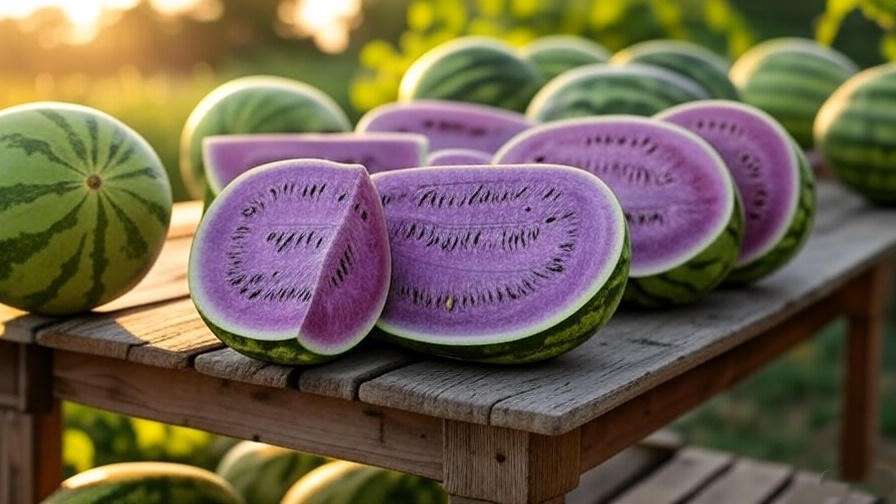
Post-Harvest Handling
Proper storage keeps purple watermelons fresh and flavorful. Store whole melons in a cool, shaded area (50–60°F or 10–15°C) for up to 2–3 weeks. Refrigerate cut melons in airtight containers for up to 5 days to maintain juiciness. For culinary versatility, try these ideas:
- Fresh Eating: Slice into wedges for a vibrant, sweet snack.
- Juicing: Blend the flesh with mint or lime for a refreshing drink.
- Recipes: Incorporate into salads, salsas, or sorbets for a colorful twist.
Saving seeds from your harvest is also a great way to continue growing these unique fruits, as detailed below.
Expert Insight: Seed Saving Techniques
Saving purple watermelon seeds ensures you can replant your favorite varieties. Follow these steps:
- Select a Ripe Melon: Choose a fully mature, healthy fruit from a vigorous plant.
- Extract Seeds: Scoop out the pulp, place it in a bowl of water, and separate seeds from the flesh.
- Clean and Dry: Rinse seeds thoroughly, then spread them on a paper towel to air-dry for 1–2 weeks in a well-ventilated area.
- Store Properly: Place dry seeds in an airtight container, labeled with the variety and date, and store in a cool, dry place.
Avoid cross-pollination by isolating purple watermelon plants from other varieties if you plan to save seeds, as watermelons are prone to cross-breeding.
Troubleshooting Common Issues with Purple Watermelons
Poor Germination Rates
Low germination can frustrate even experienced gardeners. Common causes include:
- Old Seeds: Seeds older than 4–5 years lose viability. Test a few seeds by soaking them in water; viable seeds sink.
- Improper Conditions: Soil temperatures below 65°F (18°C) or overly wet soil hinder germination.
Solutions: Use fresh seeds, maintain soil warmth with a heat mat, and ensure proper drainage. If germination fails, replant with a new batch and adjust conditions.
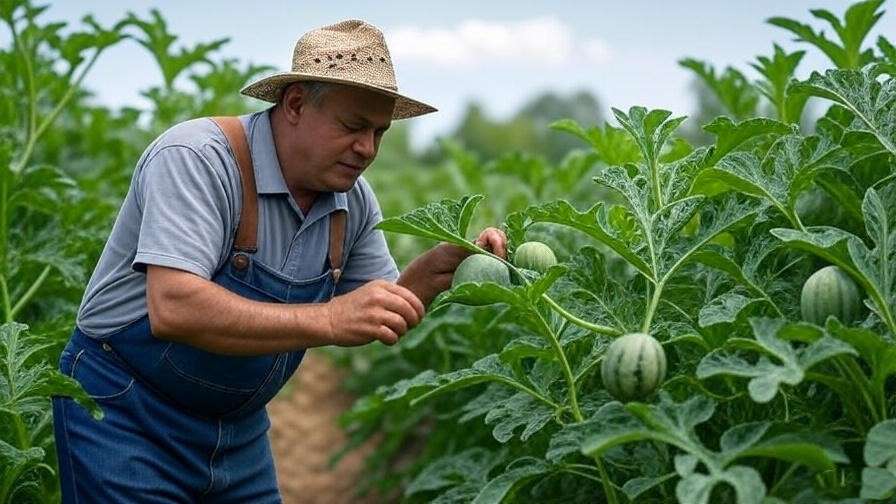
Stunted Growth or Low Yield
If plants grow slowly or produce few fruits, consider these factors:
- Nutrient Deficiency: Yellowing leaves may indicate nitrogen or potassium shortages. Apply a balanced fertilizer or compost tea.
- Overwatering: Soggy soil suffocates roots. Water deeply but less frequently, allowing the top inch of soil to dry out.
- Poor Pollination: Lack of bees can reduce fruit set. Hand-pollinate by transferring pollen from male to female flowers using a small brush.
Monitor plants weekly and address issues promptly to maximize yield.
Environmental Challenges
Purple watermelons prefer warm climates, but gardeners in cooler regions or with heavy soils can still succeed:
- Short Growing Seasons: Start seeds indoors 3–4 weeks before transplanting to extend the season.
- Heavy Clay Soil: Amend with sand or organic matter to improve drainage.
- Excessive Rain: Use raised beds or plastic mulch to control moisture.
These adaptations, drawn from years of trial and error, ensure success across diverse conditions.
The Broader Impact of Growing Purple Watermelons
Environmental Benefits
Cultivating purple watermelons supports sustainable gardening by preserving genetic diversity. Heirloom and rare varieties like these protect against crop monocultures, which are vulnerable to pests and climate shifts. By growing and sharing seeds, you contribute to a resilient food system. Additionally, organic cultivation methods—such as composting and natural pest control—reduce environmental impact, aligning with eco-conscious gardening trends.
Community and Market Opportunities
Purple watermelons are a hit at farmers’ markets and community events due to their striking appearance and novelty. A local grower in my network, Jane, turned her small purple watermelon patch into a thriving side business, selling to restaurants and at markets for $10–15 per melon. You can replicate this by:
- Marketing: Highlight the fruit’s unique color and health benefits on social media or local listings.
- Community Engagement: Host garden tours or seed swaps to share your harvest and knowledge.
These efforts not only generate income but also build connections with fellow gardeners.

Inspiring Future Gardeners
Growing purple watermelons inspires others to explore exotic varieties and embrace gardening. Share your journey online with hashtags like #PurpleWatermelon or #RareFruit to connect with global gardening communities. By documenting your successes and challenges, you motivate beginners to experiment and seasoned growers to diversify their crops, fostering a culture of innovation and sustainability.
FAQs About Purple Watermelon Seeds
Are purple watermelon seeds safe to eat?
Yes, they’re edible and packed with nutrients like protein and healthy fats. Roast them with a pinch of salt for a crunchy snack or blend into smoothies for added texture.
Can I grow purple watermelons in containers?
Absolutely! Choose compact varieties like ‘Sugar Baby’ and use a 15–20-gallon container with drainage holes. Ensure full sun and support vines with a trellis to save space.
How do purple watermelons taste compared to regular ones?
Purple watermelons are often sweeter with a slightly floral note, though flavor varies by cultivar. Their crisp texture makes them ideal for fresh eating or juicing.
What’s the best climate for growing purple watermelons?
They thrive in warm climates (USDA zones 4–9) with long, sunny days. In cooler areas, use black plastic mulch to warm soil and extend the growing season.
How long do purple watermelon seeds stay viable?
With proper storage (cool, dry conditions), seeds remain viable for 4–5 years. Test older seeds before planting to ensure germination success.
Conclusion
Growing purple watermelon seeds is a rewarding journey that combines beauty, flavor, and sustainability. From sourcing authentic seeds to harvesting vibrant fruits, this guide equips you with expert insights to succeed. Whether you’re a novice gardener or a seasoned grower, purple watermelons offer a chance to elevate your garden and inspire others. Start planting today, share your progress with fellow gardeners, and enjoy the pride of cultivating a truly unique crop. Happy gardening!

